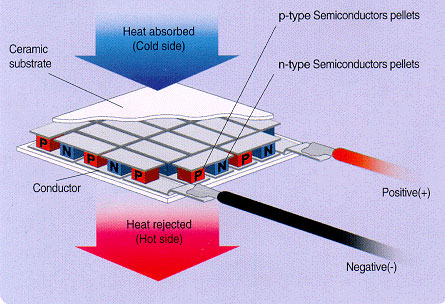|
About Thermoelectric Technology |
|
About Thermoelectric Technology In 1834, French physicist Jean Peltier discovered that when electrical current is sent through a circuit made of dissimilar conducting materials that heat is absorbed at one junction and given up at the other. This phenomenon is known as the "Peltier Effect." Evolving from Peltier's original discovery, today's thermoelectric modules (TEMs) are highly efficient heat pumps, directly converting electricity into cooling power. 
Most thermoelectric modules utilize bismuth telluride, doped to obtain p (positive) and n (negative) semi-conducting properties, to achieve optimum heat pumping performance. Sandwiched between the ceramic exterior of a TEM are many small pieces of n + p doped bismuth telluride coupled together and connected electrically in series. When connected to a DC power supply, current causes one side of the TEM to absorb heat (the cool side) while the other side gives up heat (the hot side). If the current is reversed, the heat is moved the opposite direction reversing the hot side and the cold side. With their small size, efficiency, reliability, and environmental friendliness, TEMs are becoming widely accepted as the most effective cooling source for many applications.
|
|

|
.You must login to view or make wishes
|

